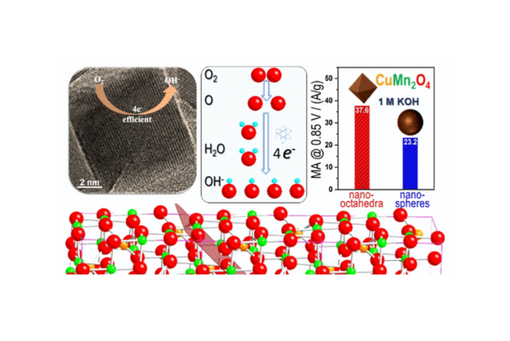Facet Impact of CuMn2O4 Spinel Nanocatalysts on Enhancement of the Oxygen Reduction Reaction in Alkaline Media
Abstract
Surface-structure engineering represents an attractive strategy to optimize the energy conversion performance of nanocatalysts using their deliberately controlled exposed facets. To further exploit the potential of non-Pt-group metal-based spinel catalysts for the alkaline oxygen reduction reaction (ORR), a cathodic fuel cell reaction, we hereby report a strategy of ORR improvement by controlling the crystallographic facets of ultra-small CuMn2O4 spinel nanocatalysts through a developed colloidal synthesis approach. The synthesis of CuMn2O4 nanocrystals with morphological control relies on the design and selection of the Cu/Mn precursors with striking discrepancies in reaction kinetics. Following carbon loading and an annealing post-treatment of the as-synthesized nanocatalysts, the exclusively {101} facet-exposed CuMn2O4 spinel nano-octahedra exhibit improved electrocatalytic activity toward the ORR in 1 M KOH, when compared to their spherical counterparts, exhibiting a mass activity (MA) of 37.6 A/g at 0.85 V. After 10,000 cycles of the ORR durability test, the nano-octahedra still retain an MA of 24.5 A/g, which is twice that of the CuMn2O4 spinel nanospheres. Structural characterizations after durability testing indicate that the MA decay is likely associated with a decrease in the Mn3+ fraction and the emergence of Cu+ on CuMn2O4 nano-octahedral surfaces. As a paradigm, this synthesis approach could be extended to other Mn-based spinel nanocatalysts with precise shape control, enabling us to understand and establish the relationship between the surface lattice/valence state and electrocatalytic properties.
Citation
Facet Impact of CuMn2O4 Spinel Nanocatalysts on Enhancement of the Oxygen Reduction Reaction in Alkaline Media
Ming Zhou, Hongsen Wang, Lihua Zhang, Can Li, Amar Kumbhar, Héctor D. Abruña, and Jiye Fang
ACS Catalysis 2022 12 (21), 13663-13670
DOI: 10.1021/acscatal.2c03275


